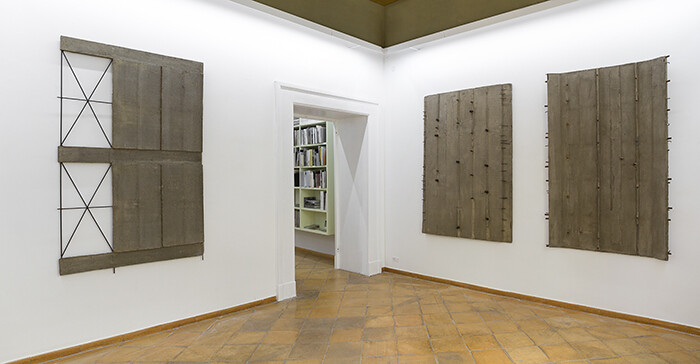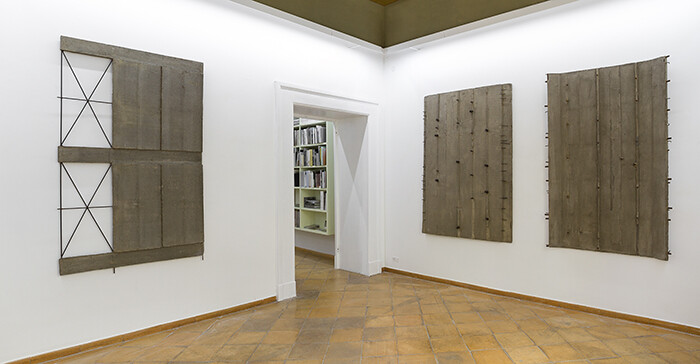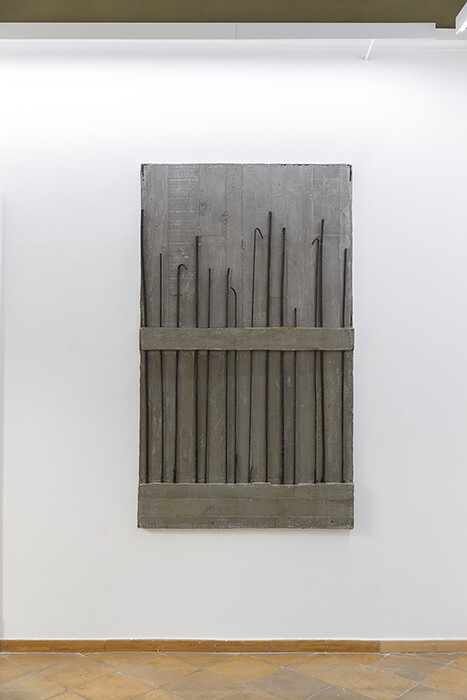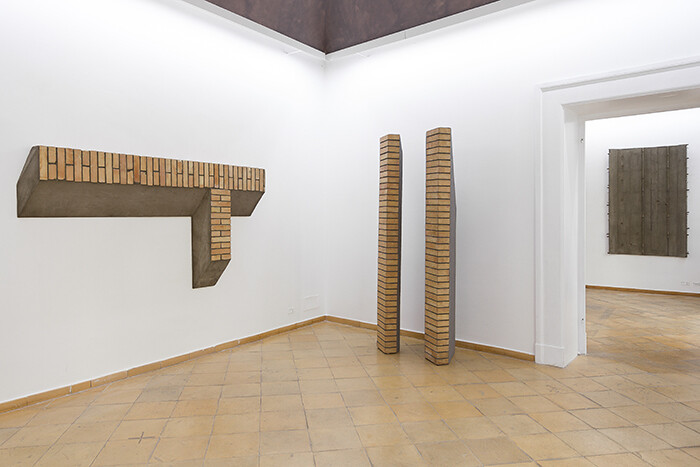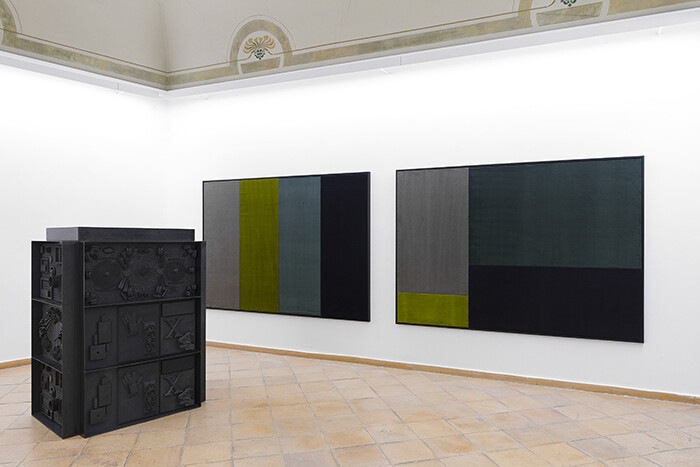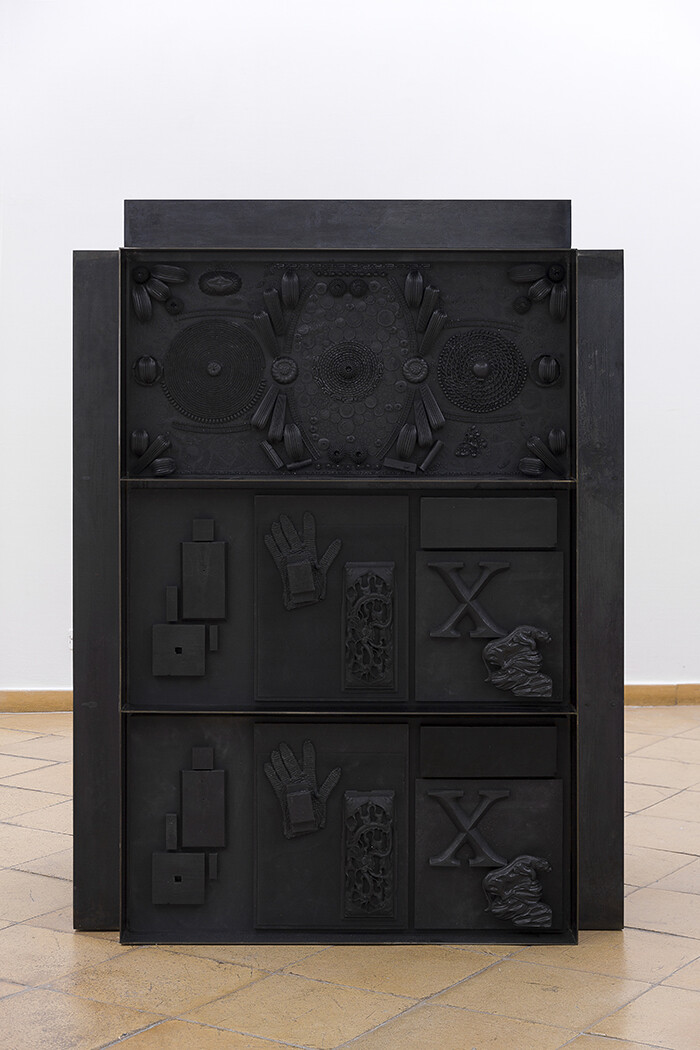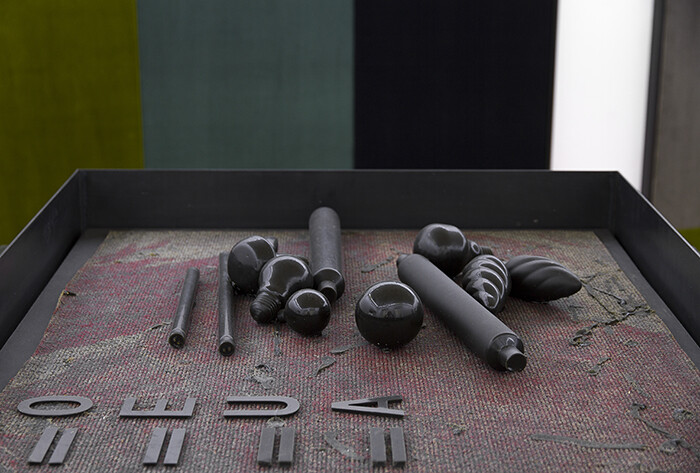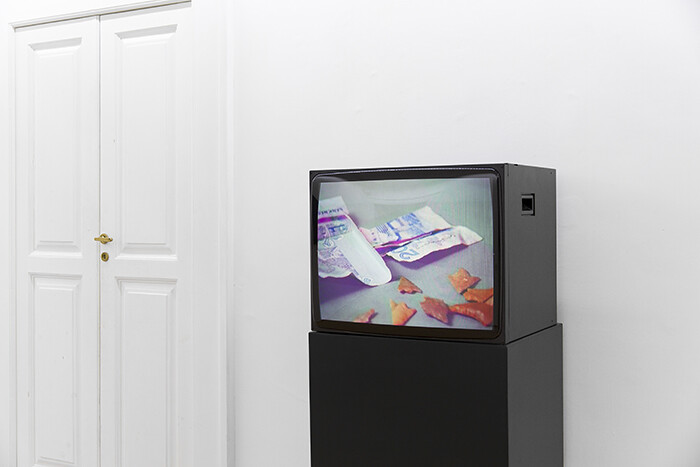Pescara is a city of concrete, much of which is not too pretty, as it dates to the postwar building frenzy, which hurriedly filled the gaps carved out by Allied carpet bombings in 1943. Benedetta Spalletti’s gallery, Vistamare (“sea view,” even if the Adriatic is too far away to be seen from the gallery—the name alludes to a family picture from her childhood), is located in a miniscule section of old houses that survived the destruction, but is so encircled by the concrete-ness of the present (a viaduct, a parking lot, a new high-rise) so as to appear under siege. With its shady courtyard and frescoed ceilings, the small palazzo is a time capsule, and, quite unusually, it hosts a permanent artwork (Sotto il tavolo [Under the Table], 1997), an immersive room covered in greenish blue pigments by Ettore Spalletti (the owner’s uncle) which offers a further walk on the Elysian side, away from all the dismaying neighbouring sights. The same confrontation between aging concrete and fragile rococo grace takes place within this exhibition, which brings together Giuseppe Uncini (1929–2008), an Italian sculptor of the same generation as Piero Manzoni (1933–63) and Enrico Castellani (b. 1930), and Paris-based Isabelle Cornaro (b. 1974), who won the Prix Ricard in 2010 and recently held twin solo shows at the South London Gallery and Spike Island in Bristol. It’s a good choice: despite the distance between the artists’ contexts, the dialogue between their works is intense. Both artists play obsessively with composition, models, casting, and work in analytical series. Both deal with the ghosts of art history by erasing and reformatting their references. And though obviously seduced by sensual surfaces and the subtleties of chiaroscuro, both turn to industrial materials, such as concrete and polymers, because of their restraint from emotional empathy.
Concrete is a shapeshifter: as old as the pyramids and the Great Wall, it is infused with modernist nostalgia and futuristic charm. When crumbling, it reverts to sand and dust. Its rough surface provides natural élevages de poussière [dust breeding]. Easy to mold, it reverberates its vanished formwork, like a footprint. In the age of digital liquidity, it has become a reasonable metaphor of a solid structure of support, a non-abstract form of material reality, which made it popular again amongst younger artists. Uncini fell in love with concrete when he moved to Rome in the early 1950s. Italy’s capital was undergoing a booming and brutal urban expansion, fuelled by the Marshall Plan. The subway’s first line opened in 1955; Uncini’s tautological Primocementoarmato [Firstarmedconcrete] was born in 1958. The iconic buildings of the 1960 Rome Olympics were designed and built in armed concrete by Pierluigi Nervi, a world master of innovative methods for shell construction. But when Uncini made cement sculptures for his first solo at Galleria L’Attico, in 1961, the reviews were unanimously angered: “The newspapers called me a mason, an incompetent, while visitors wrote nasty comments in white chalk directly on my works, as if they were walls,” he told me during an interview a few years ago, laughing at the unfiltered feedback.
The exhibition at Vistamare departs precisely from 1961, with “Cementarmato,” a series of abstract compositions, almost two meters high, where vertical iron rods pierce the raw concrete plan or emerge from it, like sketched lines on paper. When Uncini started to create large, free-standing structures, he chose mimesis over reproduction, thus opting for laminated wood covered in concrete, instead of bulky full casts. Abstraction ensued. Amongst his best works are the “Ombre” ([Shades], from the late 1960s onwards), a series which casts the negative space between geometric solids (Ombra di due parallelepipedi M.14 [Shade of two parallelepipeds M.14], 1973) or connects an architectural element with its shade, as if it had an equally tangible twin body (Colonne con ombra, [Columns with shade], 1969; Muro d’ombra n.67, [Wall of shadow n.67], 1986). In the grainy and highly tactile watercolors on paper here on display, Uncini adopts the same formal vocabulary, but finally gives in to color: gray, light brown, purple, and white give different rhythms to his geometric compositions in perpetual recombination, like the ancient five orders of architecture.
The connection with Cornaro, whose works are presented in two adjoining rooms of the gallery, is intuitive. Her new series of “Tableaux (Velvet understanding)” (2015)— in luscious velvet fabric stretched on a wooden frame, like paintings—is composed by assembling rectangular portions of textiles which share a parallel palette of grays, browns, and greens. Seen against the painted ceilings, their echoes multiply. Uncini’s Colonne find a natural counterpart in the black cubic God Box No 2 (in painted steel, plaster, and cast rubber), one of the “Homonymes” produced for the artist’s solo at Kunsthalle Bern in 2013. A unique piece, God Box No 2 evokes a locked cabinet of curiosities, whose four sides are decorated with elaborate arrangements of everyday industrial objects, from gloves to jewelry chains, old lightbulbs, and single letters from the alphabet turned into the equivalents of the bucrania and garlands of bay leaves of a Neoclassical frieze. On top, a four-letter code (A=O, O=E, E=U, U=A) suggests a logical though still mysterious order of repetition for the motifs. In Orgon Door IV (#1, black frame) (2014), Cornaro uses black elastomer to replicate, in apparent disorder, a similar set of objects, while in Orgon Door III (#2, blue frame) (2014), order prevails, with ropes and chains of different sizes diligently set out in straight lines, like the decorative moldings of an architrave. The natural light, which pours in from the gallery’s large windows, emphasizes this high relief, as much as the bas, almost invisible relief of the uneven grains of Uncini’s concrete. The gaze zooms in and out. Beware: just one look outside, to the contemporary skyline, and this small Arcadia will vanish in a blink.
